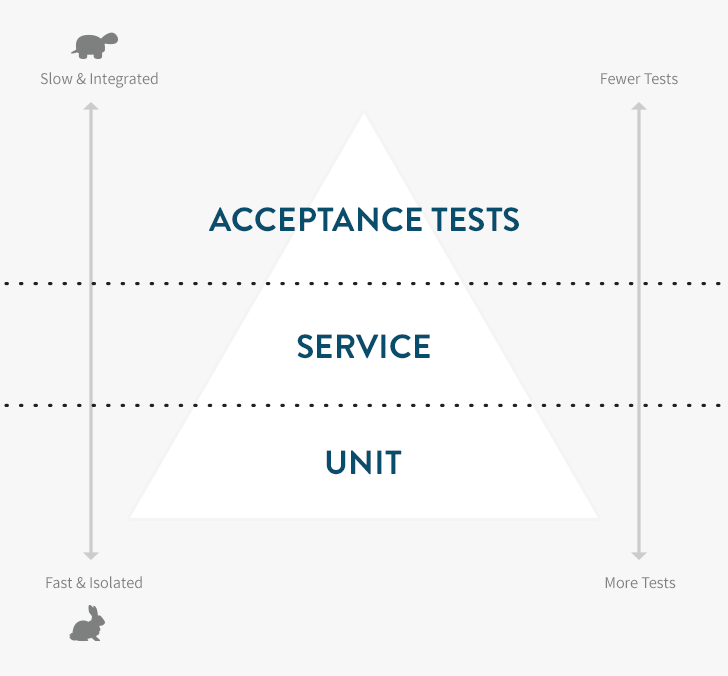The Rails Testing Pyramid
Balanced test suites for long-term maintainability
Are your tests running slower than you’d like? Or perhaps your tests are brittle, making it harder to refactor and make substantial changes to your application functionality? Both are common complaints for large Rails apps that have been around for years, but good testing practices shouldn’t create these problems over the long term.
The testing pyramid is a concept that can help you better balance your tests, speeding up your test suite and reducing the cost of changing the functionality of your applications. It centers on the composition of different types of tests in your suite.

You’re probably already familiar with the two most common types of Rails tests in the wild:
- ** Unit tests** — The lowest and most important level. Unit tests use tools like RSpec, MiniTest or Jasmine that confirm the correct behavior of isolated units of functionality (typically classes, methods or functions), and run extremely fast (milliseconds).
- Acceptance tests — The high level (typically user-level) tests using tools like RSpec and Capybara, Cucumber or Selenium. Since they run a lot more code than unit tests and often depend on external services they are much slower (seconds or minutes).
A properly tested application feature requires both unit tests and acceptance tests. Start by making sure you have good unit test coverage. This is a natural by-product of a test-driven development (TDD) workflow. Your unit tests should catch edge cases and confirm correct object behavior.
Carefully supplement your unit tests with acceptance tests that exercise the application like an end-user. These will give you confidence that all of the objects are playing nicely together. Teams often end up with way too many of these tests, slowing development cycles to a crawl. If you have 20 Capybara-based tests for user registration to confirm that all validation errors are handled correctly, you’re testing at the wrong level. This is known as the Inverted Testing Pyramid anti-pattern.
The Throwaway Test
It’s important to realize that — just like scaffolding — a test can be useful without being permanent. Imagine that you’re going to spend two weeks building a complex registration system, but you’re slicing it into half day stories each of which has a couple of Cucumber tests to verify behavior. This can be a good way to develop, as you’ve got a large number of thinly-sliced stories and are ensuring that you have clear “confirmation” that each story is complete in the form of passing acceptance tests. Just don’t forget the final step: When you’re done, pare your test suite down to the minimum set of tests to provide the confidence you need (which may vary depending on the feature).
Once you’re done with such a minimum marketable feature, instead of just shipping with the 40-50 acceptance tests you used while building out the stories, you should replace those with maybe 3-5 user journeys covering the major flows through the registration system. It’s OK to throw away the other tests, but make sure that you’re still ensuring correctness of the key behaviors — often by adding more unit tests. If you don’t do this, you’ll quickly end up with a test suite that requires substantial parallelization just to run in 5-8 minutes and that is brittle with small UI changes breaking large numbers of tests.
Service-Level Testing
Eventually, you’ll notice that there is sometimes functionality that you can’t confidently test at a unit level but that shouldn’t really be tested via the UI. In his 2009 book, “Succeeding with Agile”, Mike Cohn (who came up with the concept of “the testing pyramid” which was later popularized by Martin Fowler) used the phrase “service-level testing” to describe these tests. Various communities also use terms like functional or integration tests which also describe tests between unit and end-to-end acceptance tests.
The trick with service level testing is to expose an API for your application or subsystem so that you can test the API independently of the UI that will exercise it. This ties in nicely with trends in web application development where many teams are now trending towards building a single RESTful JSON API on the server side to service both web and native mobile clients.
Putting It All together
Most applications only have a small number of critical user paths. For an eCommerce application, they might be:
- Browsing the product catalog
- Buying a product
- Creating an account
- Logging in (including password reset)
- Checking order history
As long as those five things are working, the developers don’t need to be woken up in the middle of the night to fix the application code. (Ops is another story.) Those functions can likely be covered with five coarse-grained, Capybara tests that run in under two minutes total.
Blending unit tests, service-level tests and acceptance tests yields faster test suites that still provide confidence the application is working, and are resistant to incidental breakage. As you develop, take care to prune tests that are not pulling their weight. When you fix a bug, implement your regression test at the lowest possible level. Over time, keep an eye on the ratio between the counts of each type of test, as well as the time of your acceptance test suite.
Using these techniques, you can achieve testing nirvana: A suite that provides you confidence the application works, gives you freedom to change the application without brittle, UI-related test failures, and runs in a few minutes without any parallelization.
Peter Bell is Founder and CTO of Speak Geek, a contract member of the GitHub training team, and trains and consults regularly on everything from JavaScript and Ruby development to devOps and NoSQL data stores.